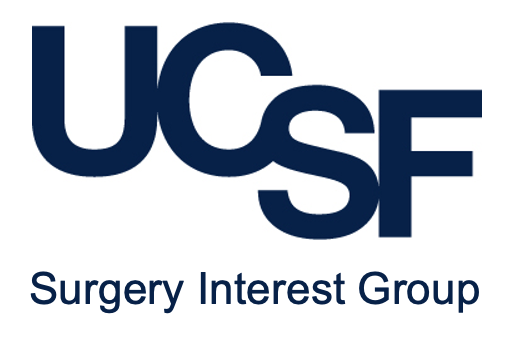Many UCSF medical students have taken the initiative to dive into surgical research either over the summer break or on top of their classes. Here, we highlight some of the research performed by members and alumni of our SIG leadership board.
James Cevallos (JMP2)
What research project(s) are you working on? I am working with Dr. Patrick Ha in OHNS at UCSF and Phil Boileau in SPH at Berkeley to determine whether or not fusion proteins can serve as neo-antigens for head and neck cancer patients. Our work focuses on salivary gland Adenoid Cystic Carcinoma (ACC), which is a head and neck cancer that impacts thousands of individuals throughout the United States. Although localized primary ACC’s can be effectively treated through surgery and radiation therapy, there are virtually no therapeutic options for patients experiencing recurrence or metastasis, which occurs in 35 to 50 percent of patients. Immune checkpoint inhibitors can be prescribed to adenoid cystic carcinoma patients. However, these immune blockades are ineffective without strong support for CD8 T cell populations. Personalized Cancer Vaccine is an innovative therapy that can be used to expand CD8 specific T cell populations in patients experiencing metastases from salivary gland cancer. The therapy harnesses the power of cancer neoantigens to stimulate tumor immunity in patients. Cancer neoantigens are novel peptides that are presented on tumors by major histocompatibility complex molecules. These cancer neoantigens can activate CD8 specific T cells that will expand and travel to metastatic sites and induce apoptosis. Different mutations and chromosomal rearrangements within cancer cells can serve as sources of neoantigens. Our work hones in on MYB/NFIB and MYBL1/ NFIB. Our research aims to quantify expression of the fusions in ACC PDX Models, ACC tumors, and normal salivary gland tissue, identify cancer neo-antigens that are generated from MYB-NF1B or MYBL1-NFIB, and validate cancer neo-antigens that are generated from MYB-NFIB or MYBL1-NFIB in vitro.
What are you most excited to learn? The immune system and ways in which we can harness personalized therapies to augment surgical procedures!
How do you hope to engage with research in your future career? I am interested in pursuing a career in academia where I can work on translational research projects.
What inspires you about surgery? Several faculty mentors that I have been connected with through the SIG & OHNS specialty career advising page at UCSF!

Joseph Kidane (MS3)
What research project are you working on over the summer?
I’m working with Dr. Hsiao in Endocrinology and Dr. Morshed in Orthopedics to conduct a retrospective chart analysis on the frequency of heterotopic ossification following total hip arthroplasty and to perform exome sequencing to identify it's underlying genetic contributors. For background, heterotopic ossification is a condition in which abnormal bone formation occurs in soft tissue like muscles, tendons, ligaments, and joints, usually following trauma. I am also creating a case report on a rare genetic disorder called fibrodysplasia ossificans progressiva, where severe heterotopic ossfication leaves people immobilized by their 30's. Specifically, we are looking at the use of an experimental medication to decrease the amount of bone formation post surgery.
What are you most excited to learn?
I’m drawn to learning about the intersections between disciplines within surgery. I’m also excited to understand the biochemical underpinnings of experimental drugs as well as genetic contributions to surgical outcomes.
How do you hope to engage with research in your future career?
I definitely want to continue doing research when I’m a physician. It keeps the brain fresh and helps advance medicine on a different scale.
What inspires you about surgery?
I love how hands-on and direct it is. I always find myself incredibly focused during surgeries and I love the team dynamic within the OR!
Natalie Kucirek (MS3)
What research project are you working on over the summer? I’m working with Dr. Alfred Kuo, a joint surgeon at the SFVA. We are looking at the basic science of fracture healing. Specifically, we are studying cell adhesion proteins in mice by sectioning tibial fractures from both male and female animals some of which have a knockout phenotypes for specific genes of interest. Eventually, we will use immunohistochemistry to characterize the differences in fracture healing.
What are you most excited to learn? I’m really interested in sex differences in research. A lot of times there aren’t female models organisms in the basic sciences because menstruation might be a confounding variable that is difficult to control. I’m excited to see if there are difference between male and female mice in our study, and I’m excited to be incorporating female organisms into my research.
How do you hope to engage with research in your future career? I one day hope to become a surgeon-scientist. Throughout medical school and residency I hope to gain more experience in the basic sciences. I want to talk to more physicians about balancing a robust clinical practice with this research and hope to bring something unique to the research world.
What inspires you about surgery? I’ve been interested in surgery for a very long time. My mom signed me up for anatomy class when I was in middle school, and I dissected different animal organs for the first time. I was fascinated by all that you can see internally that you can otherwise cannot. I like that surgery is a physical skill that I can hone and that it leads to actionable outcomes. It’s achieving progress in a concrete way.
Matthew Orringer (MS2)
What research project(s) are you working on? Matt is working with Dr. Derek Ward, an orthopedic surgeon, to examine how distance traveled to receive care relates to outcomes following total hip and total knee arthroplasty operations. He is also working with Dr. Nirav Pandya, an orthopedic surgeon, to study how increased physical load in a set time period may predispose NBA players to injury.
